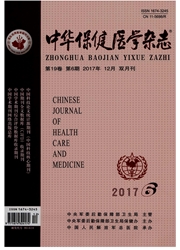

 中文摘要:
中文摘要:
目的分析维持性血液透析患者铁代谢指标与C反应蛋白(CRP)之间的相关性,探讨微炎症状态对血清铁蛋白(SF)和转铁蛋白饱和度(TSAT)的影响。方法解放军总医院维持性血液透析患者158例。其中男性97例,女性60例;平均年龄(57.9±16.6)岁。病例人选标准:(1)规律血液透析6个月以上;(2)年龄和性别不限;(3)近3个月内无出血或输血史,(4)sF≥200μg/L。病例排除标准:(1)各种严重感染;(2)严重营养不良;(3)严重心力衰竭;(4)活动性系统性疾病。根据CRP值分为A组(CRP≤8mg/L)和B组(CRP〉8mg/L),应用t检验比较两组间血清铁(Fe)、TSAT、SF和血红蛋白(Hb)水平差异;根据SF值分为组1(SF〈500μg/L)和组2(SF≥500μg/L),应用t检验比较两组间CRP和Hb水平的差异;并采用Pearson相关分析,分析全部患者的CRP水平与Fe、TSAT、SF和Hb水平的相关性。结果(1)与A组比较,B组患者SF水平显著升高(t=-1.908,P=0.049);TSAT、Fe和Hb水平显著降低(分别为t=22.422,P〈0.001:t=3.192,P:0.002;t=1.616,P=0.047)。(2)与组1比较,组2患者CRP水平显著升高(t=-3.536,P〈0.001);Hb水平(t=1.524,P=0.052)差异无统计学意义。(3)Pearson相关分析显示,Fe、TSAT和Hb水平与CRP水平呈显著负相关。结论维持性血液透析患者的SF、TSAT、Fe、Hb水平受炎症状态水平的影响,联合检测SF、TSAT和CRP有益于正确评估铁代谢状态。
 英文摘要:
英文摘要:
Objective To explore the effect of microinflammation on serum ferritin (SF) and transferin saturation (TSAT) in maintenance hemodialysis patients. Methods One hundred and fifty- eight cases of maintenance hemodialysis were enrolled, including 97 male and 60 female cases with an average age of 57.9 ± 16.6 years. Case inclusion criteria: (1) regular hemodialysis for more than 6 months; (2) Any age and gender; (3) no bleeding or blood transfusion events within 3 months; (4) SF ≥ 200 μg/L. Case exclusion criteria: (1) any serious infections; (2) severe malnutrition; (3) severe heart failure; (4) active systemic diseases. The patients were divided into group A (CRP ≤ 8 mg/L) and group B (CRP 〉 8 mg/L) according to the C-reactive protein (CRP) level. The differences of serum ferrum (Fe), TSAT, SF and hemoglobin (Hb) were compared between the two groups by t test. According to the SF level, the patients were also divided into group 1 (SF 〈 500 μg/L) and group 2 (SF≥ 500 μg/L) between which the differences of CRP and Hb were compared by t test. The correlation between CRP and Fe, TSAT, SF, or Hb in all patients was analyzed by Pearson correlation analysis. Results (1) When compared with group B, group A showed lower level of SF but higher levels of TSAT, Fe, and Hb (P 〈 0.05). (2) When compared with group 1, group 2 showed significantly higher level of CRP (P 〈 0.05). There was no significant difference in Hb between (t = 1.524, P = 0.052) groupl and group2 (P 〉 0.05). (3) Pearson correlation analysis showed that Fe, TSAT, and Hb all had a negative correlation with CRP. Conclusion The levels of SF, TSAT, Fe, and Hb are constantly affected by chronic inflammation in maintenance hemodialysis patients. Therefore, the combination tests of SF, TSAT and CRP may favor the correct assessment of ferrum metabolism state.
 同期刊论文项目
同期刊论文项目
 同项目期刊论文
同项目期刊论文
 期刊信息
期刊信息
